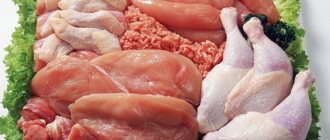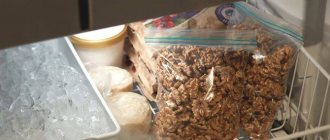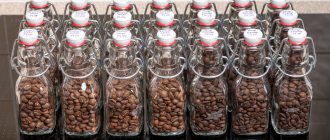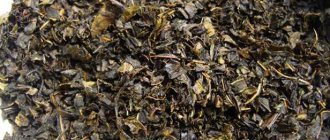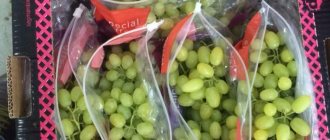Home / Complaints, courts, consumer rights / Consumer rights
Back
Published: 11/13/2018
Reading time: 24 min
0
477
In order to approve the shelf life of products, SanPiN 2.3.2.1324-03 “Hygienic requirements for shelf life and storage conditions of food products” was created. This document ensures the human right to access quality food.
- Shelf life of food: what is it?
- Food storage conditions: what they are and what they are
- Shelf life of food products
This right is also guaranteed by the following laws and regulations:
- Federal Law No. 29 of January 2, 2000 “On the quality and safety of food products.”
- SanPiN 2.3.2.1078-2001 “Hygienic requirements for the safety and nutritional value of food products.”
Vegetables, fruits, berries
Apricots, grapes, raspberries, currants, raisins, gooseberries, nectarines, peaches, prunes and horseradish are best preserved at temperatures from 0 to -1°C. Many fruits should be stored at temperatures around 0°C - broccoli, rutabaga, mustard, green beans, mushrooms, greens (including leafy greens), cabbage, leeks, lettuce, radishes, corn, kohlrabi, turnips, carrots, parsnips , rhubarb, celery, garlic, chicory, strawberries, wild strawberries. From 0 to +2°C is the ideal temperature for storing artichokes, cherries, blueberries, oranges, kiwis, cauliflower and Chinese cabbage, zucchini, peas, beets, onions, chopped fruits and vegetables, persimmons, figs, tangerines, herbs, asparagus .
+3 – +7°С is a suitable temperature for storing avocados, +3 – +6°С for cranberries. In the range from +13 to +16°C, exotic fruits are perfectly preserved - pineapple, mango, bananas, papaya, coconut, and this is also the ideal temperature for storing melons, grapefruits and cucumbers. To store basil, you need a temperature in the range from +11 to +15°C, for lemon - from +8 to +13°C, for sweet pepper - from +7 to +13°C, for eggplant - from +8 to +12 °С, for watermelon – from +13 to +21°С, for pomegranate – from +5 to +10°С, for blackberries – from 0 to +1°С, for potatoes – from +7 to +10°С, for tomatoes from +13 to +21°С, for apples – from -1 to -4°С. The best temperature for summer squash is between 5 and 10°C, and for winter squash it is exactly 10°C. Pears should be stored at a temperature of -2 to -1°C, while southern pears are stored at a temperature of +4 to +5°C.
The shelf life of vegetables, fruits and berries is not limited, but they must be inspected regularly, and if the slightest signs of spoilage appear (softening, stains, wateriness, etc.) they must be consumed as quickly as possible. Frozen fruits are stored longest at temperatures of -18°C and below. The temperature of any cellar, from +10 to +15°C, is the best temperature for storing jams.
Entrepreneurs store vegetables, fruits and berries using prefabricated refrigeration chambers, due to the large volume of these products. This type of product can be delivered to refrigerated chambers made from sandwich panels in bags or directly in containers.
List of foods that spoil quickly
- Vegetables: carrots, onions, tomatoes, beet, peppers, radishes and so on.
- Fruits, berries: melon, apple, banana, orange, pomegranate and so on.
- Mushrooms.
- Milk, cottage cheese, cream, butter, sour cream.
- Milk mixture.
- Egg.
- Fish
Most people eat meat and fish every day, so these foods are the most popular. At room temperature, these products can be stored for no more than two hours. It's the same story with dairy products.
Greens and lettuce leaves retain their beneficial properties only for one day if they are not put in the refrigerator. In the room you can only leave berries that are not yet ripe. If you put in a ripe berry, then after two days it will begin to deteriorate. Fruits and berries must be wrapped in paper. Apple, orange and pineapple can be stored in the refrigerator for up to five days. They must be placed on the bottom shelf.
Food that quickly deteriorates must be preserved according to certain rules and conditions. From the moment they are made until they are consumed. The first stage is warehouses, where workers are responsible for the products until they are shipped to stores.
If everything is done correctly, then the sellers will not rush to sell the products because they are fresh. And he won’t write them off. From the moment you purchase, the responsibility for proper storage lies with you.
The shelf life will be correct if you follow all the standards: temperature, humidity percentage and other tips recommended by the manufacturer.
Items that spoil very little can do without refrigeration. It is necessary to transport products in vehicles that have specialized equipment with the required temperature, which will be stable until the point of arrival. If you follow all the tips and rules, then storing perishable foods is easy and simple.
Meat storage temperature
Chilled meat and minced meat are kept fresh at a temperature of 0 – +2°C for about a day. It is best to defrost meat at this temperature to ensure it remains juicy. Large chopped pieces of meat can be stored for about a day at a temperature of +2 to +6°C, while frozen meat and minced meat should be stored at -18°C. Pork lasts at this temperature for about 8 months, lamb - about 10, beef - 12 months. If you store meat at a temperature of -25°C, then pork and lamb will last for 12 months, and beef – as much as 18. Baked pork, ham, uncut meatloaf, boiled, stuffed and blood sausage, liver, sausages, sausages can be stored for up to three days at temperatures from 0 to +8°C. Semi-smoked and cooked-smoked sausage can be stored at room temperature for three days, but in the refrigerator at a temperature of 0 to +8°C it can be stored much longer - up to ten days. Sausages can be frozen: at -9°C, half-smoked sausage is stored for 3 months, boiled smoked sausage is stored for 4 months, and raw smoked sausage is stored for 9 months. Lard is stored at a temperature not exceeding +1°C. Opened canned meat can be stored at temperatures from 0 to +8°C for up to two days.
For storing meat in utility rooms, universal refrigerated cabinets with a combined mode are most often used, and for sale - combined refrigerated display cases with temperatures from -5..to +5 degrees Celsius (for example, Carboma VHSr-2.0 or Polyus VHSr-1.2 Eco).
Meat by-products can be stored at temperatures up to 8°C for 12 hours, at temperatures from 0 to +6°C for two days, at 0°C for up to three days, and at -18°C for up to four months. Meat broths and soups, jellied meats, jellies, jellied meat, brawn can be stored at a temperature of +4 to +6°C for no more than 72 hours. The pate can be stored at a temperature of 0-6°C for up to two days, and frozen to -9°C for six months. Poultry meat can be stored at temperatures up to +8°C for a day, and at temperatures from 0 to -4°C – up to three days. Frozen poultry - chickens, turkeys, ducks, geese are stored at a temperature of -12 to -15°C. At the same time, chickens and turkeys are kept fresh for up to ten days, and ducks and geese for up to seven days. Geese and ducks can be stored for a year, and turkeys and chickens even 14 months at temperatures of -25°C or lower. Frozen rabbits are stored at -9°C for up to six months.
How long does food last in a container without refrigeration?
If the unit is missing or broken, many people wonder how long the products will be able to retain their freshness. The most perishable foods include meat and fish. They should not be left at room temperature for longer than 2 hours. If meat and fish are boiled, fried, stewed or baked, they will not spoil within 48 hours.
The easiest way to increase shelf life is to place food in a vacuum container. Thanks to preliminary pumping of air from the bag, which promotes the growth of bacteria, meat and fish will remain fresh for up to 3 days.
The storage duration standards specified in SanPiN take into account the type of food and the recipe for its preparation. If the finished dish contains dressing or cream, the shelf life is reduced. Knowing the requirements for storing food in the refrigerator will allow you to avoid poisoning caused by eating spoiled food and unnecessary financial costs.
Video: rules for storing in the refrigerator
20 REFRIGERATOR Rules | Competent Organization | REFRIGERATOR Merchandising| How to store Products
Watch this video on YouTube
Do you want to understand better than others?
- Shelf life of frozen food - Freezing seasonal vegetables and fruits in the freezer is one of the most popular ways to prepare food for a long time. Low temperatures help preserve...
- Shelf life of food products according to SanPiN - Improper storage of food products can lead to poisoning and problems with the human digestive system. Therefore, these activities should be approached with…
- Key rules for freezing and storing fresh mushrooms: Mushrooms can only be collected for a few months a year. But cooks want to use them more often, so they find different ways to prepare them. Mushrooms are often stored in the freezer...
- Terms and rules for storing kefir in the refrigerator - The duration and rules for storing fermented milk products are regulated by strict requirements, since the presence of active compounds in such items limits the period...
- Rules and terms for storing finished dough in the refrigerator - If the housewife does not have much time to knead the dough from start to finish, preparing the product and storing it for a long period of time comes to the rescue. Dough…
Storage of dairy products
Fresh unpasteurized milk can be stored at 8°C for up to 6 hours, and at 4°C for up to a day. Pasteurized and boiled milk and cream can be stored at a temperature of +4 – +8°C for up to three days, and slightly longer at a temperature from 0 to +6°C. Powdered milk in a sealed metal container does not spoil for about eight months if stored at a temperature of 1 – 10°C. Opened condensed milk can be stored for no more than three days at a temperature of 0 to +8°C.
Butter should be stored at a temperature no higher than +6°C - this way it will remain fresh for up to ten days, and frozen to -10 - -12°C, it can be stored for up to ten months. Margarine can be stored at temperatures from 0 to +4°C for two months, and at temperatures from -20 to -10°C for up to three months. Ice cream, depending on the variety, can be stored from one to six months in chest freezers at temperatures from -18 to -30°C. Cottage cheese and curd products, kefir, yogurt, sour cream, sweet cream cheese are best stored at a temperature of +2 - +6°C. Cheeses are usually stored at temperatures from +2 to +10°C.
Dairy products are stored in refrigerated cabinets in the warehouse (large and capacious Polair (CM 110-S) ШХ-1.0 or smaller Polair (CM 105-S) ШХ-0.5 are best suited)
Carrying out concreting
Now let's figure out how to fill the ceiling in the cellar. After all, now we need to prepare the formwork correctly and fill it with concrete. This must be done as quickly as possible. To do this, start preparing a cement mortar that will have binding properties and have fillers - sand and crushed stone. This can be done either using a concrete mixer or manually. How to cover a cellar ceiling is now in detail.
Attention. It is best to use concrete with a grade of at least 200. This will significantly strengthen the structure and extend its service life.
So:
- Fill the formwork in several passes, but in one direction. When pouring the mixture, do not forget to compact it so that there are no voids inside.
- It is important to ensure the strength of the ceiling slab. Check for unevenness using a building level.
- Make sure that the solution is not exposed to direct rays of the sun, wind or drafts. Carefully ensure that the poured slab is not subject to various mechanical influences.
- Water the stove with plain water for a week to ensure it cools evenly. You can then work with the slab after 21 days, at which time you will remove the formwork itself.
- The quality of concrete floors will depend on the materials chosen. Choose cement M-250 or M-400 (with the addition of special heavy fillers).
- Before starting work, calculate the size of the room and the required amount of building materials. This way you can save money.
When you make a concrete floor yourself, you think through and install all the necessary communications yourself. When the flooring is laid on top of the slabs, level the surface with a self-leveling mixture. You can equip the hatch to the basement with a secret handle that will not interfere with walking.
Storage temperature of fish and seafood
Fresh fish and shellfish should be stored at a temperature of 0 to -1°C and consumed as quickly as possible, as these are perishable products. Frozen fish is stored at a temperature of -18°C for three to ten months, depending on the type of fish. At the same temperature you can store fish and crab sticks for a long time. At temperatures from -5 to -6°C, frozen fish can be stored for up to two weeks, and at temperatures around 0°C – for three days. Hot smoked fish can be stored in a temperature range from -2 to +2°C for three days or more, and if it is frozen to -30°C, it can be stored for up to thirty days, but before selling such fish it should be thawed at a temperature up to +8°C. Cold smoked fish can be stored at temperatures from -2 to -5°C for up to 75 days; herring, mackerel and mackerel – from 45 to 60 days; balyks of herring, mackerel, horse mackerel, notothenia, whitefish - from 15 to 30 days. Required temperature for storing lightly salted and marinated fish: 0 – +1°C. Dried and dried fish can be stored at temperatures from -5 to -8°C for up to a year. No more than +2°C - this is the required temperature for storing boiled shellfish, lobsters, shrimp and crabs. Live oysters, mussels and other bivalves can be stored for several days at a temperature of +5 – +10°C.
Requirements for labeling, conditions and shelf life of perishable products
Over the past decade, the range of food products on our shelves has grown significantly. How can a buyer, inexperienced in the intricacies of new technologies, correctly and consciously choose exactly the product he needs? It’s not easy, but the only way: pay close attention to the labeling, learn to read the label, or, as it is now commonly called, “consumer information.”
Labeling is information about a product, a set of information, mainly in the form of text, applied to a product, packaging (container), tag (tag) or label, which ensures the consumer’s right to an informed choice of the product purchased. Mandatory data when labeling consumer packaging includes: - name of the product or its type, grade (if divided into grades), - net weight or capacity (volume), - designation of the regulatory document for this type of product. Additional data when labeling consumer packaging includes: - information about nutritional value, - information about conditions and shelf life, - shift number and date of production, - composition of the product, - for perishable loose goods, the label must also contain the following information: date (time) of manufacture, shelf life in the container of manufacture, date (time) of packaging, shelf life of the packaged product.
According to the labeling, the buyer can: - choose a manufacturer and buy those products that satisfy him in terms of quality and taste; — evaluate the composition of the product: the presence or absence of preservatives, dyes, stabilizers and other food additives, GMO content.
Information about the composition of the product is very important for some buyers, because some components cannot be used in food for certain diseases (allergic reactions, diseases of the central nervous system, etc.); - adjust the consumption of proteins, fats, carbohydrates, regulate calorie intake, thereby ensuring balanced nutrition; — ensure the correct temperature conditions for storing the product; - consume the product within the prescribed time frame, ensuring its quality and safety.
The buyer should know that proper storage of products allows them to preserve their nutritional and biological value and protects the product from spoilage. Food spoils mainly as a result of exposure to microbes. The life of microorganisms depends on the external environment: humidity, temperature, etc. etc. and if storage conditions and periods are violated, microorganisms can multiply in products that can cause spoilage, and as a result, food poisoning and acute intestinal diseases. Products that cannot be stored without refrigeration are perishable products, these are meat, fish, cottage cheese and vegetable semi-finished products, culinary products, milk and dairy products, sausages, minced meat and products made from them, cream confectionery products. Their maximum shelf life is very short (from 6 to 72 hours) depending on the type of product (with the addition of preservatives and other food additives, the shelf life of perishable products increases).
Hygienic requirements for food storage are simple and accessible to everyone. To prevent spoilage of perishable products, they must be kept in the refrigerator and certain rules must be followed: - placing products in the refrigerator should take into account that various products and ready-made dishes require a certain storage temperature - from -23 * C to + 6 * C; — food products must be placed taking into account air circulation in the refrigerator; It is not recommended to tightly fill the refrigerator with products, which may cause a violation of the temperature conditions of storage inside the volume of products; — it is necessary to keep information about the shelf life of purchased products; before putting fish or meat in the freezer, you should wrap them in a plastic bag and keep the label indicating the name of the product, date of packaging and shelf life. For products stored in consumer packaging, it is necessary to leave information about the production date and shelf life; - be sure to observe the shelf life and sale dates for purchased products and dishes prepared from them; they should not be consumed after the date indicated on the packaging. The consumer has the right to receive all necessary information about the product.
Other products
Chicken eggs can be stored at a temperature of + 3 – +6°C for 25 days, and in a temperature range from -1 to -2.5°C – up to six months. Quail eggs can be stored for up to three months at temperatures from 0 to +5°C. Bread stored at -8°C practically does not go stale. Honey storage temperature is +5 – +10°C. Yeast is stored in the following temperature conditions: compressed yeast - from 0 to +4°C, liquid yeast - from +4 to +10°C. After being in the refrigerator, compressed yeast should be thawed at a temperature no higher than +8°C. Salads seasoned with sour cream and mayonnaise, as well as vinaigrettes, are stored at +4 – +6°C. Baked goods with perishable fillings, cakes and cream pies are best stored at a temperature of +1°C, and the permissible temperature range is from 0 to +5°C. Rum baba, muffins and rolls can be stored at temperatures from +5 to +18°C.
How to protect yourself from eating low-quality products?
When purchasing food products, you should pay attention to the expiration date indicated on the label.
A few tips regarding product quality:
- You should buy perishable goods at the market in the morning before they melt.
- When buying products in a store, you need to inspect the label for signs of peeling off. If there are traces of glue, it means the product has been relabeled because its expiration date has expired. There is no need to buy such products.
- If any product smells bad, it is spoiled, and should not be purchased.
- When the product is unpacked, the shelf life decreases. Therefore, it is better to eat it immediately or put it in the refrigerator for a short time indicated on the label.
- If you have doubts about the quality of a product, it is better not to buy it.
- If possible, heat treat the products.
What goods are perishable?
Products that have a short shelf life are called perishable. Such goods are extremely demanding on the conditions in which they are stored and transported. Additional certificates are required to pass them through customs.
In most cases, perishability means:
- Fresh or chilled meat and meat products,
- Fresh or pasteurized milk or milk products,
- Fish products, seafood, fresh and frozen fish,
- Bird eggs,
- Fresh fruits and berries,
- Vegetables and salads from fresh vegetables,
- Natural fruit juices and drinks,
- Fresh greens,
- Cakes, pastries and other confectionery products,
- Tree seedlings, bushes, decorative flower bulbs.
Get a detailed and free consultationAdd message text I agree with the privacy policy Add Thank you for contacting our company! Our manager will contact you soon
Categorization of perishable products
In 2021, the above-mentioned State Standard, which defines the main categories of perishable product categories, remains in effect:
- Fresh vegetables, as well as purees from them.
- Fresh fruits, puree and dough from them.
- Fresh mushrooms.
- Fresh meat products, including lard, fats, endocrine and offal.
- Dairy products and live cheeses.
- Eggs.
- Fish products.



